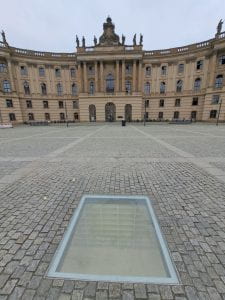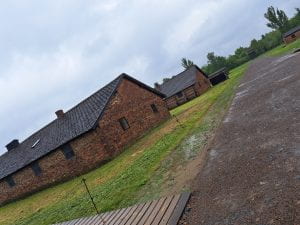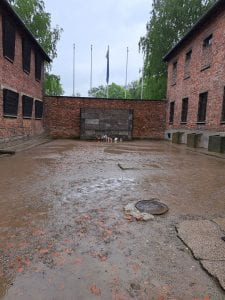As I explored the museums in Berlin, I observed a strong effort to maintain what the conflict meant for Germany, even when it was difficult or reflected poorly on the nation. The Topography of Terror Museum explained the horrors committed by the SS and Gestapo. The museums was simply laid out and long text descriptions retold the history in detail. One display that described the murders of Soviet POWs by Gestapo and SS agents stood out to me in particular. Another image showed Gestapo and SS officials enjoying dinner, possibly after executing three Poles earlier that day. Both these displays underscored the brutality of the Gestapo/SS when dealing with Eastern Europeans and how industrialized their actions became.

Gestapo Dinner
The German Resistance Museum gave a different perspective but still maintained the same level of detail. Numerous walls were devoted to acknowledging the Germans who actively resisted the Nazi regime, even when it cost them their lives. The museum also gave special attention to the failed July 20th assassination attempt and commemorated Claus Von Stauffenberg for trying to kill Hitler. Similar to the Topography of Terror Museum, there were long text descriptions, but there were also far more photographs sharing the faces of Nazi resistance.
Even though these museums share very different sides of Germany in WWII, they both provide the same perspective on the country’s collective memory of the conflict. Germans accept their role in starting the conflict and the atrocities that were committed over the course of the war. These museums didn’t try to cover up the Nazi’s actions or rid themselves of the blame, they presented the information bluntly. At the same time, there is a desire to remember how the German people did maintain some sliver of humanity, which was evident in the Resistance Museum. Out of all the countries we visited, the museums here interested me the most because I wasn’t sure how the information would be presented. Although it may have been a bit much to read sometimes, the museums provided the information clearly and it was fascinating to be in spots where history took place.


 The exhibits then progress through the rise of the SS in Germany and the victims of the brutal organization. As the SS rose along with the backing of the Nazi Party, Germans who supported the regime effectively supported the SS. This support for the Nazi Party also supported the SS concentration camps, extermination camps, and the continuance of the organization’s extra-legal status. After the war, many claimed that the Nazi regime’s oppressive control left Germans no choice but to engage in its genocidal policies; however, exhibits such as the ones displayed in the Topography of Terror refute this claim. With the seemingly unanimous support that the Nazi Party had, it is certain that many supported the SS as well, not only due to the oppressive control of the regime.
The exhibits then progress through the rise of the SS in Germany and the victims of the brutal organization. As the SS rose along with the backing of the Nazi Party, Germans who supported the regime effectively supported the SS. This support for the Nazi Party also supported the SS concentration camps, extermination camps, and the continuance of the organization’s extra-legal status. After the war, many claimed that the Nazi regime’s oppressive control left Germans no choice but to engage in its genocidal policies; however, exhibits such as the ones displayed in the Topography of Terror refute this claim. With the seemingly unanimous support that the Nazi Party had, it is certain that many supported the SS as well, not only due to the oppressive control of the regime.


























